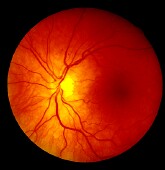Retinal atrophy mirrors whole-brain atrophy over time, as measured by optical coherence tomography
WEDNESDAY, July 22, 2015 (HealthDay News) — Rates of ganglion cell + inner plexiform layer (GCIP) atrophy mirrors that of whole brain atrophy in multiple sclerosis (MS), as measured by optimal coherence tomography (OCT), according to a study published online July 18 in the Annals of Neurology.
In order to validate the utility of OCT as an indicator of neuronal tissue damage in patients with MS, Shiv Saidha, M.B.B.Ch., from Johns Hopkins University in Baltimore, and colleagues examined whether atrophy of specific retinal layers and brain substructures are associated over time. They performed biannual cirrus high definition OCT in 107 patients with MS.
The researchers observed a correlation between rates of GCIP and whole-brain, gray matter (GM), white matter (WM), and thalamic atrophy. There was a stronger correlation for GCIP and whole-brain atrophy rates in progressive versus relapsing-remitting MS (RRMS) (r = 0.67; P < 0.001 versus r = 0.33; P = 0.007). In RRMS, the correlation between rates of GCIP and whole-brain (and GM and WM) atrophy increased incrementally with step-wise refinement to exclude ON (eyes with a past history of optic neuritis) effects; the correlation increased to 0.45 and 0.60, respectively, excluding eyes and then patients, consistent with effect modification. Lesion accumulation rate correlated with GCIP and inner nuclear layers atrophy rates in RRMS.
“Our findings support OCT for clinical monitoring and as an outcome in investigative trials,” the authors write.
Several authors disclosed financial ties to the pharmaceutical and biotechnology industries.
Copyright © 2015 HealthDay. All rights reserved.








